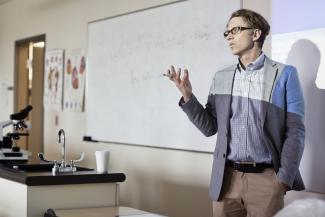
Do the preparation task first. Then listen to the audio and do the exercises.
Preparation
Transcript
In today's lecture we're going to be talking about experiments, and I thought it might be interesting for you all to learn about the world's oldest continuously running laboratory experiment that is still going today. In fact, it holds the Guinness World Record for being the longest-running experiment. This experiment began in 1927 and has been going ever since.
It's called the 'pitch drop' experiment and it was created by Professor Thomas Parnell at the University of Queensland, Australia. Parnell was the university's first physics professor, and he wanted to show in this experiment that everyday materials, such as pitch, can have quite surprising properties.
You see, when pitch is at room temperature, it feels solid. You can easily break it with a hammer. However, it isn't in fact solid. At room temperature, pitch is many billions of times more viscous than water, but it's actually fluid.
In 1927, Professor Parnell took a sample of pitch. He heated it and poured it into a glass funnel. He allowed the pitch to cool and settle – for three years. He then turned the funnel upside down and cut the top off it.
Since then, the pitch has slowly dropped out of the funnel. How slowly? Well, the first drop took eight years to fall. It took another forty years for another five drops to fall. Today it's been almost 90 years since the experiment started. Only nine drops have fallen from the funnel. The last drop fell in April 2014 and the next one is expected to fall in the 2020s.
The experiment has a tragic story associated with it. Professor Parnell died without seeing a pitch drop. His replacement, Professor John Mainstone, became responsible for the pitch drop experiment from 1961. He held the job for 52 years, and missed seeing the drop fall three times – by a day in 1977, by just five minutes in 1988 and finally in 2000, when the webcam that was recording the experiment suffered a power outage for 20 minutes, during which time the pitch dropped.
The pitch drop experiment is something we can all participate in now. There's a live web stream that allows anyone to watch the glass funnel and wait for the fateful moment. A similar experiment to the Queensland pitch drop was set up in Dublin, and the video of the moment the pitch actually dropped went viral on the internet. It's interesting to see how a very slow event can spread news so quickly.
Discussion
Language level
Topics
- Log in or register to post comments
- Log in or register to post comments
- Log in or register to post comments
- Log in or register to post comments
- Log in or register to post comments
- Log in or register to post comments
- Log in or register to post comments
- Log in or register to post comments
- Log in or register to post comments
- Log in or register to post comments



